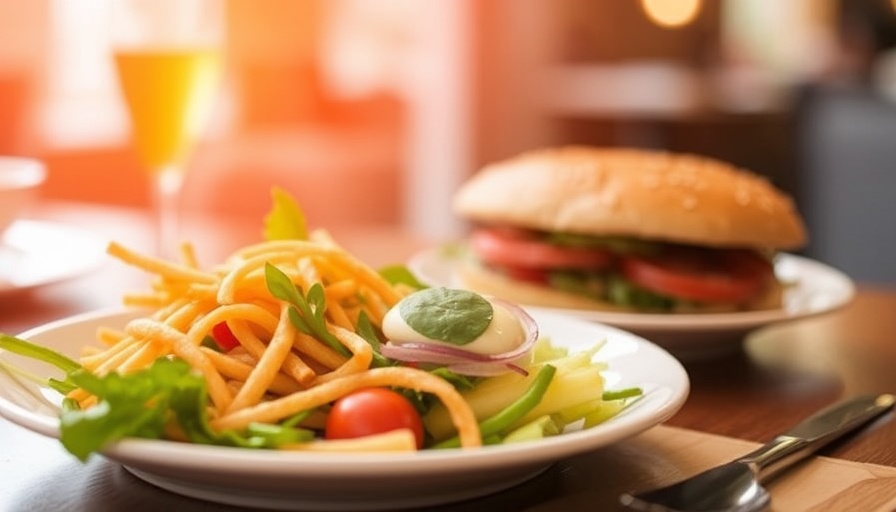
Mastering Restaurant Meals: Stress-Free Tracking Tips
Dining out should be a joyful experience, especially in a community where diverse cuisines abound. However, for those of us who want to keep an eye on our nutritional intake, tracking meals at restaurants can often feel overwhelming. Between lengthy menus, varying portion sizes, and unclear nutrition information, many diners struggle to log their meals accurately. Thankfully, expert insights can pave the way for a more pleasant dining experience without the stress of recording every bite. Here are some practical strategies shared by MyFitnessPal dietitians that will put you on the right track when dining out.
1. Plan Ahead: Choose Your Venue Wisely
Visualize this: you stroll into a cozy restaurant, excitement flaring in your belly. But wait — can you accurately log this meal later? The key here is preparation. As Dietitian Katherine Basbaum notes, some chain restaurants with 20 or more locations are legally required to provide nutritional information, making logging a breeze. To make tracking easier, familiarize yourself with the menu beforehand. Knowing the sides available can help you swap richer components for lighter ones, which can simplify your logging process.
Denise Hernandez, another MyFitnessPal expert, emphasizes the importance of sticking to familiar dishes. Meals like spaghetti with meat sauce are more likely to have entries in the food database. It’s all about making the logging process smoother!
2. Portion Control: Utilize Visual Cues
Let’s face it, restaurant portions can often resemble 'family-style' servings. Luckily, your hands can serve as a practical measuring guide! RD Daisy Mercer shares a Hollywood tip: consider your palm as a serving for protein, your fist for carbs, and two cupped hands for vegetables. This not only gives you approximate portion sizes but also makes it much easier to track your intake. If you find the serving too generous, allow yourself to reframe the experience: eat mindfully, box up leftovers, and adjust your food log to reflect the actual portion consumed.
When you take a few moments to slow down, savor the flavors, and reflect on how much of each dish you actually consumed, it transforms dining into a more mindful experience.
3. Strategy in Simplicity: Make Smart Swaps
Choosing what to order can dramatically impact how easily you can log that meal. Katherine Basbaum suggests opting for simpler dishes like baked potatoes or steamed vegetables over richer options like scalloped potatoes or creamy soups. Words like 'steamed,' 'roasted,' or 'baked' usually signify lighter cooking methods, which not only make for healthier choices but are often easier to log as well. When you're ordering, think fresh and simple!
4. Embrace Technology: Using Apps Effectively
With the rise of technology, tracking meals on the go has never been easier. Utilize tools available on platforms like MyFitnessPal. A quick search for your meal can reveal calorie counts, nutritional breakdowns, and even help you plan ahead for future restaurant outings. It’s a great way to learn about healthy dining options in your community and stay on top of your health goals.
5. The Social Aspect: Engaging with Friends and Family
Dining out is often as much about the people you’re with as it is about the food. Share a meal with friends or family and discuss the nutritional choices you’re making. This not only helps in making healthier choices more enjoyable but also promotes accountability. When dining culturally and socially, staying committed to your goals can sometimes be as simple as having your loved ones involved.
6. Building Confidence in Your Choices
With these tips in hand, it’s crucial to remember that tracking your meals is about progress, not perfection. Not every meal will fit perfectly into your logging strategy, and that's perfectly okay. The goal is to develop a healthier relationship with food while enjoying your time out. Engaging with your food positively, choosing wisely, and utilizing the resources available to you will arm you with confidence while dining out.
As we savor delightful meals in our vibrant community, let’s also take a moment to appreciate the importance of informed and mindful eating. Whether it’s through conscious meal choices or personal engagements with dining companions, your health journey can truly flourish in the diverse culinary landscape we call home.
Take Control of Your Dining Experience
With these insightful strategies, you can transform the potentially stressful experience of tracking restaurant meals into an opportunity for mindfulness and enjoyment. Consider adopting a proactive approach next time you dine out, making it a fun journey rather than a chore. The steps you take today can pave the way for healthier habits tomorrow. So go ahead, explore, enjoy, and embark on your next culinary adventure with confidence!
 Add Row
Add Row  Add
Add 



Write A Comment